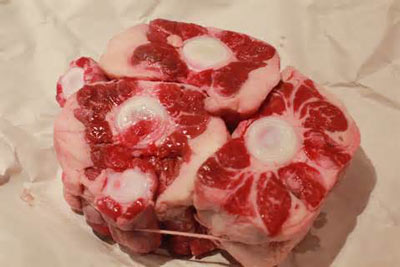Oxtail brawn derived from a Victor Gordon recipe.
Gordon personified the culture of English amateur eccentricity. Editor, among other occupations, of an obscure scientific journal “dedicated,” as he said, “to boron chemistry”, he also contributed to Raymond Postgate’s iconic Good Food Guide and wrote the strange and wonderful English Cookbook, a 1985 effort to reconcile traditional English elements with the French nouvelle cuisine, an enterprise as unmoored as anyone might imagine. It is unclear how he considered brawn (the uglier American term is headcheese) an analogue to anything French, but we should be grateful he did. “Better than pig’s head brawn,” as Gordon claimed. The recipe is not at all difficult but requires at least two days. About two pounds of big meaty oxtail rounds will yield a quivering terrine of three by five by seven inches.
 about 2 lb wide oxtail rounds
about 2 lb wide oxtail rounds- 2 Vidalia or other unpeeled sweet onions, quartered
- 3 oz malt vinegar
- 12 oz bottle (or can) porter
- about 3 pints hot rich beef stock
- Worcestershire
- four carrots
- a few bay leaves
- 1 teaspoon whole peppercorns
- heaped teaspoon dried thyme
- 6 oz Port
- salt and pepper
- heaped Tablespoon chopped chives or scallion greens
- heaped Tablespoon chopped parsley
- 2 or 3 chopped pickled walnuts (depending on budget)
Preheat the oven to 375˚.
- Roast the oxtails in a deep pot until some of their fat renders, usually in about 10 minutes, then add the onions.
- Ten minutes later add the vinegar and cook until it reduces to syrup, usually in less than 10 minutes: You will need to monitor the reduction process.
- Add the porter, let its bubbles subside, and then the stock, carrots, bay, peppercorns, thyme and Worcestershire. Skim any scum from the surface of the liquid with two or three passes 5 minutes apart.
- Reduce the oven temperature to 325, cover the pot and cook the oxtails until the meat falls from the bone, usually in about three hours.
- Remove the meat from the stock but allow it to continue cooking, uncovered, for another 30 minutes or so.
- Let the meat cool just enough to handle, then strip the meat from the bone, removing, as Gordon instructs, “every particle of fat from the pieces of tail.” Shred the meat.
- Strain the stock and refrigerate it overnight.
- Remove all the fat that has solidified in a thick layer atop the stock, which now should be a robust, wobbly jelly. If it is liquid instead, reduce it by half; you will still have a lot more jelly than you need.
- Add the pot to the jelly and cook it until it melts, then check the seasoning to ensure, as Gordon says, that the stock is “fairly pungent.”
- Toss together the shredded meat, chive, parsley and pickled walnut. Drop the mixture into a terrine or mold of appropriate size. “Do not,” Gordon again, “pack it in too tightly.”
- Pour the warm but not boiling stock into the terrine to cover the contents, cover the brawn and refrigerate it overnight.
- Turn out the brawn to slice in thickish slabs for service with more pickled walnuts or cornichon.
Notes:
-We have added the Porter and Worcestershire; Gordon considers our mandatory Port optional.
-Like all other recipes for oxtail, Gordon’s original version underestimates the required cooking time and by a lot.
-The meat is easier to remove from the bone and shred while still warm.
-Gordon, who likes playful names for recipes, calls this one “A Summer’s Tail,” but it will be welcome on most tables any time of year.

